2nd Annual Threatened And Endangered Parks: Overcrowding And Visitor Management
There are, across the National Park Service, a number of parks that draw large crowds of visitors, crowds that in some places are stretching the shoulder seasons and challenging park managers to get creative when it comes to protecting natural resources and dealing with the heavy visitation. The problems are not new, but return and grow year after year.
Acadia National Park in Maine will be tested in the coming year to see if its visitor use plan succeeds in managing the crowds and protecting resources. But there are a number of parks that continue to seek the right solution for their landscapes.
Rocky Mountain and Yosemite national parks this past year resorted to reservation systems to manage visitation in the face of the coronavirus pandemic, but they don't currently plan to continue the practice in 2021 unless the pandemic dictates it. The list of parks that struggle at times with vehicle traffic includes Arches, Glacier, Grand Canyon, Rocky Mountain, Yosemite, and Zion.
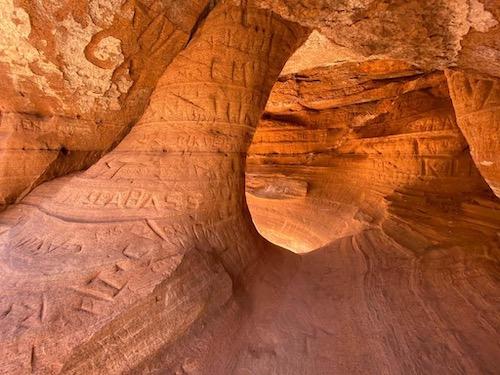
Overcrowding, and disrespect, have carved up parts of Zion National Park/NPS
Zion National Park, Utah. Endangered
Zion National Park long has struggled with growing crowds in its scenic canyon, crowds that can make it hard if not impossible to find parking, and which also take a toll on the park resources. Nearly 4.5 million visitors headed into the red-rock wonder in southwestern Utah during 2019, and while 2020 visitation looked to be down about 1 million due to Covid restrictions, the park nevertheless struggled to manage crowds.
Visitors have defaced rockfaces with spray paint and by scratching their initials into the soft sandstone, and trampled vegetation by straying off designated trails.
"Depending on the area damaged and what the surface is, it can take park staff hours to remove using a variety of equipment that has to be carried to the site," said a Zion release issued late in 2020 in a plea to visitors to restrain themselves. "Graffiti and other forms of damage to park resources are harmful and illegal. Repair of vandalized sites is costly and time consuming. Often, a damaged site can never be fully restored to its original condition.”
A drop in ranger patrols during this past summer saw visitors get even more disrespectful, as they left behind nine pounds of excrement in the iconic "Narrows" of the park.
All the while, park staff has been strategizing for years to come up with a management plan that protects park resources, improves the visitor experience, and keeps gateway businesses happy. Among the options that have been under consideration is a reservation system for all front-country areas of the park, or a reservation system for specific areas, such as the Temple of Sinawava and Angels Landing.
Arches National Park, Utah. Threatened
Vehicle congestion grows so great at times at this southeastern Utah park that the Utah Highway Patrol has in the past blocked entrance to keep the line to the park's entrance gate from backing up onto U.S. 191. While park managers in 2016 thought a reservation system was the solution, concerns over the potential economic impacts to the surrounding area eventually spurred the Interior Department to quash the reservation proposal.
That decision sent Arches' staff back to the drawing board. Late in 2019 public meetings were held to discuss the issue, and in February the staff is expected to resume conducting surveys and studies in search of a solution.
Part of the problem is that Arches has only one main entrance; another part is that there are fewer than 1,000 official parking spots in the park. Suggestions for solving the congestion have ranged from instituting a shuttle system, with parking outside the park, to constructing a second entrance near the northwestern corner of the park.
Big Cypress National Preserve, Florida. Threatened
Big Cypress is an endangered park due to the possibility that new oil reservoirs could be found and lead to development and landscape damage, and is also threatened by visitation. Overcrowding and graffiti are not problems at the preserve, but there are concerns that the park's draft backcountry management plan might be ignoring resource impacts to provide for visitor access and enjoyment; much, much greater access, to the detriment of the preserve's natural resources, in the eyes of critics.
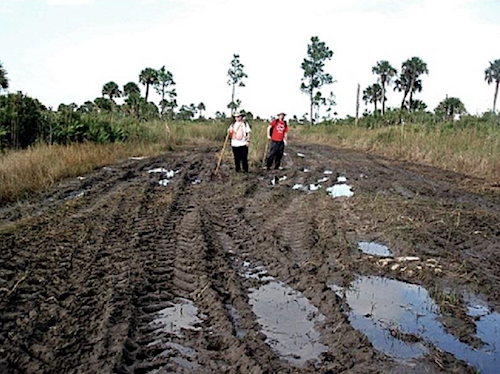
There are concerns that a backcountry management plan being developed at Big Cypress could lead to rutting of the landscape similar to that seen in 2008 in the preserve's Bear Island District/South Florida Wildlands
Though park officials say their chosen alternative "provides the greatest amount of public access to the preserve while providing for protection of cultural and natural resources," a former Big Cypress superintendent takes exception to that portrayl. John Donahue, who was superintendent at Big Cypress from 2000 to 2003 and oversaw the preserve's 2000 off-road vehicle plan, criticized the draft plan for overrunning resources and important habitat and perhaps threatening the flow of the "river of grass" from Lake Okeechobee to Florida Bay.
"Big Cypress National Preserve is the habitat and nursery for the majority of the extant Florida Panthers, the most endangered animal in North America and numerous other species that are rare, endangered, or otherwise critical to the environment," Donahue wrote in his comments to the draft plan. "It is not clear how you can reach a finding on the impact to the Florida Panther when the subject actions being examined are not clear or purposefully outlined. The vague future recommendations are not sufficient evidence to meet your obligations under the Endangered Species Act.
"The essential role that the preserve plays in providing the sheet flow for the Everglades and other areas is never really fully appreciated," Donahue continued. "The changes and additional trails proposed without the necessary specificity to evaluate them properly is likely to resume the major impact to the flow of water across the preserve."
An analysis of the draft backcountry plan by the South Florida Wildlands Assocation found the plan, if approved, "would result in 220 miles of re-opened trails – or an approximately 80 percent increase in ORV trail length compared to the existing 287 miles of ORV trail currently open to ORV permit holders. That existing trail network was carefully selected by NPS staff for suitability and sustainability at the time the 2000 plan was implemented."
"NPS has not demonstrated any need to open up additional trails to motorized recreation that would make the ecological and financial costs worth it," wrote Matthew Schwartz, the association's executive director, in comments to Big Cypress Superintendent Thomas Forsyth. "Soils, vegetation, hydrology, plants, and wildlife will all be negatively impacted in one of the premier hotspots for biodiversity in North America. And there are also the impacts to thousands of folks who enjoy the preserve on foot – including many of the secondary trails currently closed to motor vehicle traffic.
Sharing Donahue's concern that the Big Cypress staff hadn't closely evaluated all the impacts of their preferred alternative is Alison Kelly, a senior attorney for the Natural Resources Defense Council.
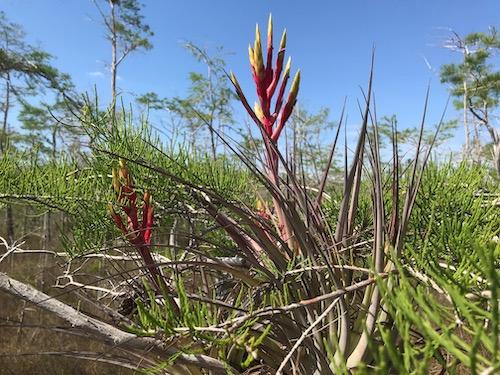
Big Cypress harbors a unique ecosystem of flora and fauna/Kurt Repanshek file
"While backcountry planning is important, it should not be used to expand access for oil and gas companies. Burnett Oil Company has already damaged the preserve by driving 33-ton trucks off-road through its wetlands looking for oil," she said. "The National Park Service must study and disclose to the public the impacts caused by this oil hunt, along with any proposed recreational off-road vehicle use, which could compound that harm. Also, this plan appears to rely on the oil company to mitigate harm to wetlands, but we have seen that this approach does not prevent damage, including to the preserve’s namesake trees."
The preferred alternative also puts at risk potential wilderness in Big Cypress, said both Donahue and the National Parks Conservation Association, which submitted comments in collaboration with Audubon Everglades, Center for Biological Diversity, Defenders of Wildlie, Friends of the Everglades, the Sierra Club, NRDC, the International Dark Sky Association, the South Florida Audubon Society, and the Tropical Audubon Society.
"The (preserve's) Wilderness proposal is listed as a foundational document for this proposal. The minimization of the wilderness proposal by the previous director was a travesty and the original proposal was one of the best ever compiled by the NPS, having answered every questions and criticism launched by the Southeast Regional Office and the Washington Office of the NPS," Donahue pointed out. "This is important to your proposal because the unwarranted disposal of eligible Wilderness allows the NPS to carve up some of the most important wilderness in the system into recreational areas for off road vehicle use in defiance of the Executive Order by President Nixon on management of ORVs on public lands. It is sad because the areas now being proposed for sacrifice by the agency actions include areas that are pristine exactly because they are so remote that they could not be impaired previously by either ORV or airboat usage.
"It appears now that the NPS intends to create access to those same areas," he wrote. "So, in effect, what God and Mother Nature would not allow to be impaired by recreational pursuits, the NPS will spend taxpayer dollars to inflict upon the most primordial wilderness areas in the United States."
Comments NPCA and the other conservation groups filed said the Park Service should "develop a new (draft environmental impact statement) that properly upholds the NPS’s conservation mandate and does not inappropriately elevate recreation over the preservation of the Preserve’s resources." The draft plan, they said, "risks subjecting eligible wilderness areas to inappropriate uses and adverse impacts. In addition to this key concern, the overall lack of scientific evaluations of potential impacts to endangered species, wetlands, night skies, soundscapes, and visitor experiences..."
Glacier National Park, Montana. Threatened
Driving towards the sun in Glacier National Park can be a challenging effort during the peak visitation season, and finding a parking spot to enjoy the high country at Logan Pass is even more challenging. Visitation growth in areas like Logan Pass and Avalanche has led to vehicle closures and restrictions to prevent traffic gridlock and ensure emergency vehicle access.
The problems are not new. Back in 2015 park staff set to work to find a solution to traffic jams, insufficient parking, and crowded trails along the Going-to-the-Sun Road. Ideas that have been discussed to solve the problems have included expanded shuttle bus operations, a few more hiking trails, and more parking.
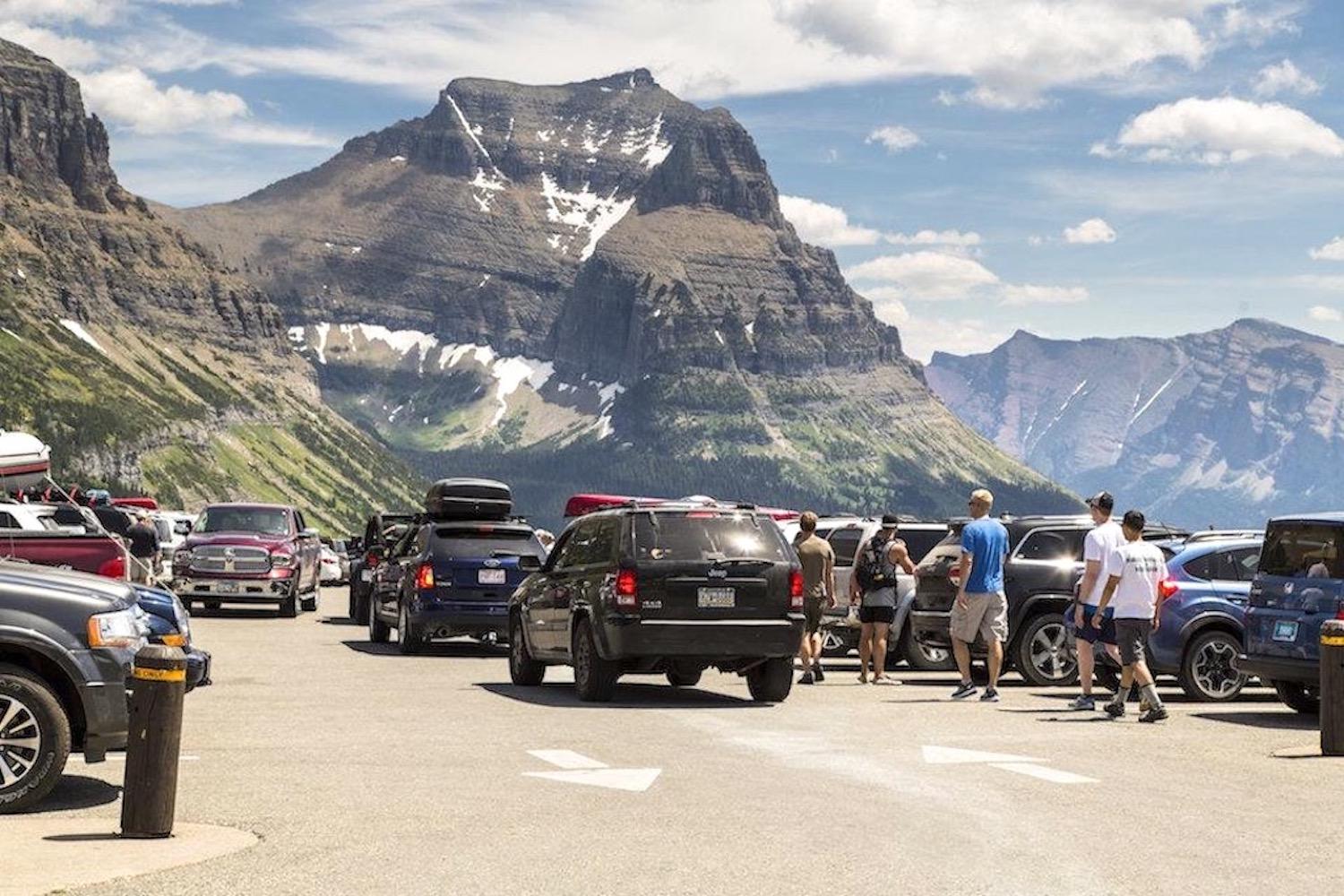
Congestion along the Going-to-the-Sun Road to Logan Pass has been a longstanding problem at Glacier National Park/NPS file
"Maintaining a quality experience while sustaining the park for generations to come will continue to be a community conversation as we develop tools and implement strategies to address substantial increases in visitation to our park and surrounding local areas," Glacier Superintendent Jeff Mow said back in September 2019.
Under the preferred approach, the park would "expand the shuttle system to include new stops and associated parking/trail projects, increase ridership, and expand hours; implement a timed entry parking permit system to manage congestion at Logan Pass and St. Mary and Virginia Falls Trailheads; and implement changes to the circulation and parking availability in the Avalanche Developed Area."
Great Smoky Mountains National Park, Tennessee/North Carolina. Threatened
With one main, popular, and commercial route across the park, Great Smoky has an obvious problem for trying to spread out its visitors. The fact that the 11-mile-loop around Cades Cove is arguably the prime attraction to the park exacerabates the crowding problem in one tiny section of the 522,427-acre park.
Cruise about the park during the summer high season and the impacts will be visible through your windshield: lines of cars parking on road shoulders because trailhead parking is full, motorists running over 'No Parking' signs, and visitors heading to streams to cool off armed with tubes.

Too many cars, and not enough parking, leads to resource damage at Great Smoky Mountains/NPS file
Park staff has seen the problems, and has been asking visitors what they think.
“We look forward to working hand-in-hand with our local communities and visitors from across the country to thoughtfully address growing challenges associated with extremely high visitation,” Great Smoky Superintendent Cassius Cash said in October. “Congestion at the most-visited park in the nation is complex, but we believe by working together, we can find solutions that help us continue to protect the park and provide better experiences for millions of visitors.”
Since 2009, annual visitation to the Smokies has increased by 32 percent, resulting in congested roadways, overflowing parking lots, roadside soil erosion, vegetation trampling, and long lines at restrooms and visitor center facilities. The park received a record 12.5 million visits in 2019. If the National Park Service's visitation website is to be believed, Great Smoky was on pace to surpass 21 million visitors in 2020.
Mount Rainier National Park, Washington. Threatened
With steady flows of visitors from Seattle and Tacoma whenever the sky is blue and "the mountain is out" all heading to the Nisqually Entrance on the park's southwestern corner, the growing crowds are turning what might have been an hour or so drive into a multi-hour slog on summer weekends and holidays. While Seattle is two or more hours' drive from Rainier's Nisqually Entrance on good days, getting through the entrance and up to Paradise at times can turn into four-hour treks.
Park officials are fully aware of the congestion problems, and are working to find a workable solution.
Visitation to the park increased 30 percent from 2008 to 2018. The park experiences extremely concentrated use with 70 percent of the more than one million visitors arriving between July and September, with the busiest times occurring on sunny weekend days.
Further, most visitor use is concentrated in a relatively small number of popular destinations such as the Paradise area, and in overlooks and trails including Carter, Comet, and Christine and Narada Falls.
“This plan is important to help us prepare for a future in which we continue to provide high-quality visitor experiences” said Superintendent Chip Jenkins. “Mount Rainier has experienced increasing visitation over the past decade. This summer, public lands across Washington State are also experiencing increasing numbers of visitors. We cannot afford to delay our efforts to address sustainable recreation.”
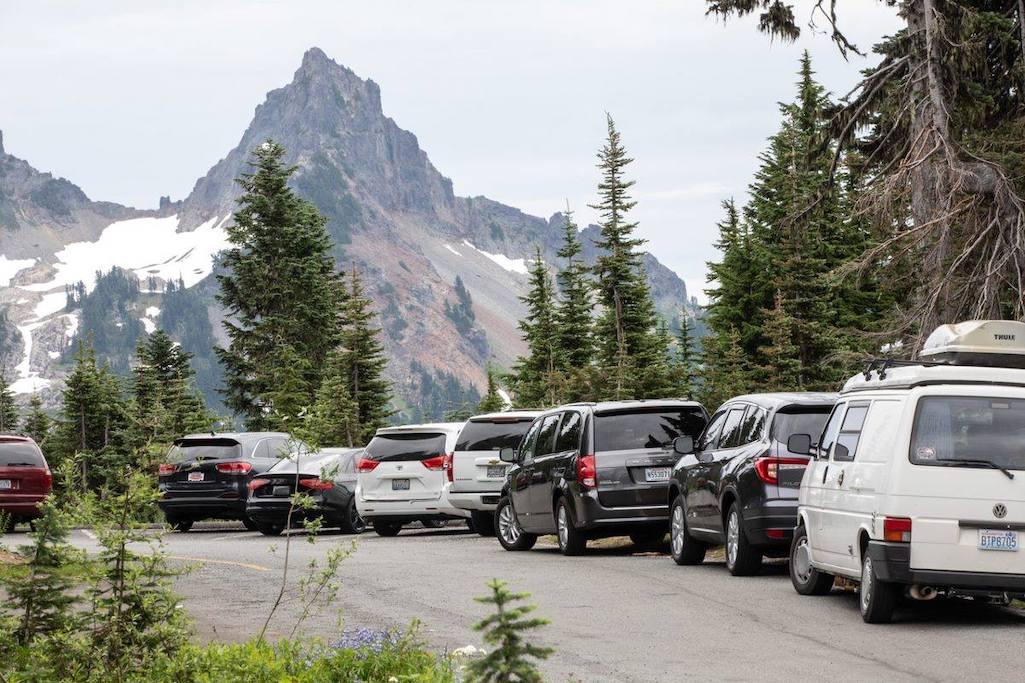
Congestion at times along the Nisqually to Paradise corridor in Mount Rainier can create parking problems, such as at the Paradise picnic area/NPS file

Comments
Thank you for your work. The task at hand is monumental I just hope that the American people and government step up to the plate it's the best thing we have to offer we cannot give it up.
Excellent article! The NPS "find your park" ad campaign was very successful (perhaps too successful) in encouraging people to visit national parks. We live in Montana, and mostly avoid both Glacier and Yellowstone in the summer because of crowds and bad behavior. Its time to stop promoting park visitation, beef up law enforcement within the parks, and ration use of certain sensitive areas.
It's not only affecting the big name parks, but Cuyahoga Valley has seen the effects, especially on weekends. Lying between the cities of Cleveland and Akron, it easily accessible to the populations of both as well as the rest of northern Ohio. The Covid-19 restraints have dramatically increased visitation. The two problems that have had the biggest impact are parking and vandalism. Even though parking areas have been expanded over the last ten years, it hasn't been enough for the current influx of visitors. Unfortunately, since the volunteer program has been suspended, there are less eyes and ears to maintain stewardship over the resources.
I recently visited Zion and did the Narrows trail, and I felt like I was at an amusement park. There were so many crowds, tour buses, and helicopters that it ruined the beauty of it.